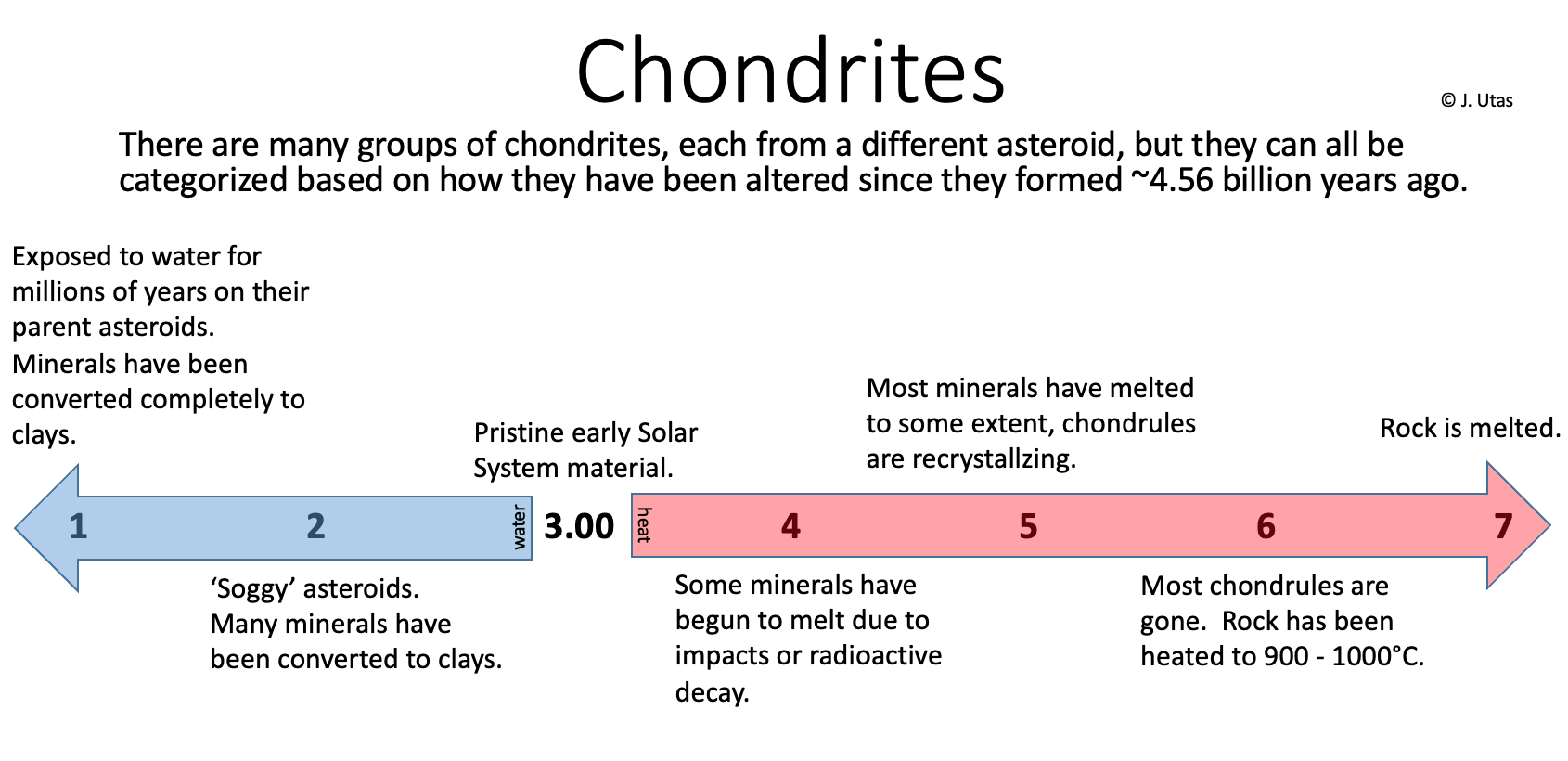chondrite classification
From the chondrite information page, the petrographic classification scheme works kind of like this:
completely altered by water into clay (no known examples)
1 – more water => nearly completely turned into clay, chondrules rare (example)
2 – a little water => some alteration of minerals into clays (example)
3 – unaltered starting material (example)
4 – some heat => a little remelted (example)
5 – more heat => chondrules getting fuzzy (example)
6/7 – even more heat => chondrules almost entirely recrystallized, hard to recognize (example)
recrystallized via heating, no recognizable chondrules (example)
From this scale, one would think that all chondrites start at 3.00, and that they are either heated or aqueously altered.
But water isn’t heat. Meteorites can be altered by water ( => classified as less than 3.00) and also be altered by heat (=> classified as greater than 3.00). There’s no real continuum across the boundary at 3, even though the classification structure is founded upon that idea. In reality, many meteorites should probably get two classifications. One less than or equal to 3, and one greater than or equal to 3.
An example: “CV3” carbonaceous chondrites almost always show evidence of aqueous alteration:
Yet CV chondrites are almost never classified as less than CV3 (with a single exception) and the CV class generally ranges from “CV3.0” to “CV3.8,” and then up into the CK’s, which are classified from 3.8 up to type-6:
The reason why this happened; it’s hard to say in some cases. Most CV chondrites are easily classifiable based on how much heat they’v been exposed to. While many might also be classified as type ~2.6 or so based upon their degree of aqueous alteration, the thermal metamorphism classification scheme was applied to them first, and it stuck. Since a meteorite is classically regarded as having a single classification (unless it’s polymict or something like that*), the one-class system (heat or aqueous alteration) chosen for a given class of meteorites is (or at least was) a subjective choice.
And it’s not just the CV’s. CO chondrites exhibit the same problem. Some even seem to texturally grade into the CM’s, although there are chemical and isotopic differences between those two groups. Other groups that have this problem include nearly all carbonaceous chondrite groups, L and LL-chondrites, and possibly even E and R chondrites. The classification scheme applied to most classes is usually the more inclusive one:
Some have proposed that the current classification scheme be split, and that each chondrite should be given a ‘thermal metamorphism’ classification (3+) and an ‘aqueous alteration’ classification (< 3). This would resolve many issues, but it would require a breadth of research and a thorough understanding of the range of characteristics exhibited by many different chondrite groups. And scientists the world over would need to accept the new structure. It probably won’t happen any time soon.
*Breccia nomenclature is easy to get the hang of if you know your Greek roots. There are three important ones: mono, poly, and mict.
Poly means “many.” Mono means “one,” or “single.” And mict means “mixed.”
Polymict is a term applied to breccias. A polymict breccia contains a mixture of clasts of different material. E.g. two different asteroids collide and are mixed together (photo), or a big impact occurs and rocks of different types from the same body are mixed together (photo).
A monomict breccia contains clasts of the same rock type (photo). It’s still a jumbled up rock — but there’s only of one kind of stuff.
